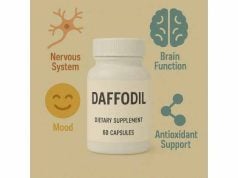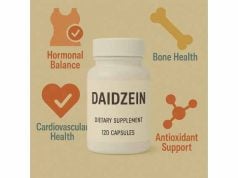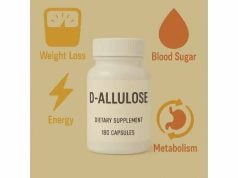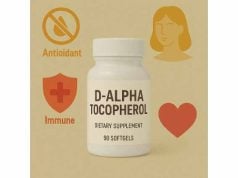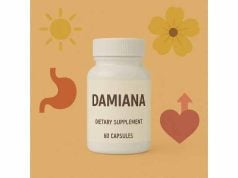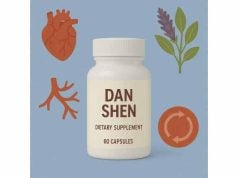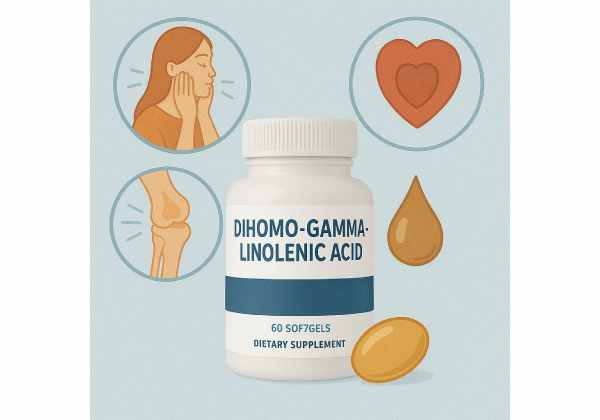
Dihomo-gamma-linolenic acid (DGLA) is a lesser-known omega-6 fatty acid your body makes from gamma-linolenic acid (GLA). Despite belonging to the omega-6 family, DGLA stands out because it’s a precursor to prostaglandin E1 (PGE1) and 15-HETrE—lipid messengers linked with vasodilation, platelet regulation, and a more balanced inflammatory response. Early human data suggest potential benefits for seasonal allergy symptoms, cardiometabolic risk markers, and platelet biology, while small trials show DGLA supplementation can raise blood DGLA without obvious short-term safety issues. Because most supplements on shelves contain GLA (the precursor), knowing how to convert that into meaningful DGLA levels—and when direct DGLA makes sense—is key. Below, you’ll find what DGLA is, how it works, what the evidence really shows, how to use it, dose ranges grounded in clinical studies, and safety guardrails.
Essential Insights for Dihomo-gamma-linolenic Acid Users
- May support a healthier inflammatory balance and platelet regulation.
- Small RCTs suggest 314–450 mg DGLA/day improved seasonal allergy scores in some measures.
- Typical trial doses: 314–450 mg DGLA/day; start low and reassess after 4–12 weeks.
- Avoid if you have a bleeding disorder, take anticoagulants/antiplatelets, or have surgery scheduled.
Table of Contents
- What is DGLA and how does it work?
- What are the proven benefits?
- How to use DGLA: forms and stacking
- How much DGLA per day?
- Safety, side effects, who should avoid
- Research summary and gaps
What is DGLA and how does it work?
Dihomo-gamma-linolenic acid (DGLA; 20:3n-6) is an omega-6 fatty acid formed inside the body from gamma-linolenic acid (GLA; 18:3n-6). The pathway looks like this: linoleic acid (from food oils) → GLA (via delta-6 desaturase) → DGLA (via elongase) → arachidonic acid (via delta-5 desaturase). That middle step—DGLA—isn’t just a waystation. It’s a bioactive node with downstream signaling roles that differ meaningfully from arachidonic acid.
Why that matters: DGLA is converted by cyclooxygenase (COX) enzymes into “series-1” prostaglandins such as PGE1, and by 15-lipoxygenase (15-LOX) into 15-HETrE (15-hydroxy-eicosatrienoic acid). These mediators are often associated with gentler, counter-regulatory effects compared with the “series-2” prostanoids and leukotrienes derived from arachidonic acid. In lab and ex vivo platelet models, DGLA can be turned into 15-HETrE, which dampens platelet aggregation and interferes with pro-thrombotic signaling cascades. Mechanistically, this has been tied to actions on intracellular signaling pathways (e.g., PKC, calcium flux) and nuclear receptors (PPARs), and to inhibition of 12-LOX activity—nudging platelets toward a less reactive state.
Enzyme preferences help explain why DGLA doesn’t always dominate signaling. COX-1 and COX-2 can use both DGLA and arachidonic acid, but COX-1 tends to favor arachidonic acid. In tissues where COX-1 is dominant, boosting DGLA may not fully displace arachidonic pathways unless dietary and enzymatic levers are also adjusted (for example, by reducing arachidonic acid formation or balancing with omega-3s). This is one reason strategies to raise DGLA sometimes combine: (1) supplying GLA or DGLA itself, (2) moderating conversion to arachidonic acid (e.g., via delta-5 desaturase activity considerations), and (3) co-supplementing long-chain omega-3s to keep arachidonic acid in check.
Practically, you can obtain DGLA two ways: directly (as DGLA-enriched oil) or indirectly by taking GLA from evening primrose, borage, or black currant seed oils and letting your enzymes convert it. Direct DGLA raises blood DGLA predictably in weeks. With GLA, responses vary with genetics (FADS1/FADS2), micronutrient status (zinc, magnesium), insulin resistance, and age. That variability explains mixed clinical results in older GLA trials for skin and joint conditions and why newer work often measures actual DGLA levels, not just intake. Think of DGLA as a targeted “omega-6 with a twist”: it sits at a crossroads where enzyme traffic determines whether the body makes more pro-resolving, vasodilatory messengers or continues down a more pro-inflammatory lane.
What are the proven benefits?
The evidence base for DGLA is growing but still modest, with the strongest human data in three areas: allergic rhinitis symptoms during pollen season, cardiometabolic risk associations, and platelet biology.
Allergic symptoms (seasonal rhinitis). A small randomized, double-blinded, placebo-controlled trial in healthy adults used 314 mg/day of DGLA for 15 weeks spanning cedar and cypress pollen seasons. Participants receiving DGLA reported lower sneezing and nasal blockage scores on one primary scale versus placebo, with trends on others. While encouraging, the study was small, industry-funded, and limited to one population; results need replication across larger, more diverse cohorts and head-to-head comparisons against antihistamines or intranasal steroids. Still, it offers a first controlled human signal that DGLA can influence allergic symptom burden when pollen exposure is real-world and sustained.
Cardiometabolic markers and outcomes (associations). Observational work in elderly patients post-myocardial infarction found that higher serum phospholipid DGLA was associated with lower all-cause mortality over two years, even after adjusting for age, BMI, kidney disease, diabetes, and other factors. This doesn’t prove causality—DGLA is likely a biomarker for broader lipid network dynamics—but it aligns with DGLA’s mechanistic profile (PGE1 and 15-HETrE favor vasodilation and less thrombotic signaling). Whether raising DGLA actively improves outcomes remains untested in large randomized trials.
Platelet function and vascular biology (mechanistic and ex vivo data). Human platelet experiments show that providing DGLA leads to formation of 15-HETrE, which directly reduces collagen- and agonist-induced aggregation. The effect involves PPAR signaling and down-modulation of 12-LOX activity, suggesting a complementary pathway to aspirin that could, in principle, influence thrombotic tone. Clinical translation is the leap: we need trials measuring bleeding risk, thrombotic endpoints, and interactions with antiplatelet drugs.
Inflammation balance and skin/joint health (mixed legacy from GLA). Older studies using GLA (the DGLA precursor) in atopic dermatitis and rheumatologic conditions showed variable benefits, likely due to differences in dose, conversion efficiency to DGLA, background diet, and lack of DGLA level monitoring. Contemporary reviews emphasize that DGLA’s role is nuanced: shifts in the DGLA\:arachidonic acid ratio, enzyme activity (delta-5/desaturase), and omega-3 status jointly determine whether the inflammatory milieu trends calmer or not.
Bottom line. Today’s best-supported outcomes are modest improvements in seasonal allergy symptom scores in one controlled trial, inverse associations of DGLA with mortality in a post-MI cohort, and strong mechanistic evidence for antiplatelet signaling via 15-HETrE. That’s promising—but preliminary. Expect clearer guidance as larger, independent trials report.
How to use DGLA: forms and stacking
Choose a form.
- DGLA-enriched oil (direct): If available, this is the most predictable way to raise serum DGLA within 2–4 weeks. Clinical studies have used standardized capsules to deliver defined DGLA amounts (e.g., ~314–450 mg/day).
- GLA oils (indirect): Evening primrose, borage, and black currant provide GLA that your body converts to DGLA. Conversion varies with genes (FADS1/FADS2), zinc status, insulin sensitivity, and age. Using GLA is common when direct DGLA is hard to source, but measure expectations accordingly.
Timing and with meals.
DGLA and GLA are fat-soluble; take with a meal that contains some fat to aid absorption. Consistency matters more than clock time—daily dosing is standard.
Stacking strategies to favor DGLA biology.
- Pair with omega-3s (EPA/DHA). This can help restrain arachidonic acid accumulation and promote a lipid mediator profile biased away from pro-thrombotic/pro-inflammatory outputs. EPA/DHA also have independent cardiovascular and anti-inflammatory benefits.
- Mind delta-5 desaturase (D5D) activity. D5D converts DGLA to arachidonic acid. Diets high in refined carbs/insulin spikes may raise D5D activity. Conversely, improving insulin sensitivity (exercise, fiber-rich diet, weight management) may help keep more DGLA available for PGE1 and 15-HETrE pathways.
- Micronutrients. Zinc appears relevant to desaturase efficiency; deficiency can skew the linoleic-to-DGLA conversion. Ensuring adequate zinc (and general micronutrient sufficiency) is a low-risk way to support the pathway.
- Background fats. A diet overly rich in arachidonic acid (fatty meats, certain organ meats) may counteract DGLA’s balance effects. Replace some sources with fish/seafood, legumes, nuts, and extra-virgin olive oil to support a friendlier lipid mediator mix.
What to combine cautiously or avoid.
- Antiplatelet/anticoagulant drugs. Because DGLA can generate 15-HETrE (antiplatelet), combinations with aspirin, clopidogrel, warfarin, DOACs, or high-dose omega-3s warrant clinician oversight.
- Upcoming surgery. Stop supplemental DGLA/GLA at least 1–2 weeks before procedures unless your surgeon approves.
- Pro-inflammatory triggers. High trans-fat intake, sedentary habits, and poor sleep can overwhelm any subtle DGLA benefits. Lifestyle alignment boosts your return on investment.
Setting expectations.
In trials, symptom changes during pollen season emerged over weeks, not days. For general inflammatory balance, plan to re-evaluate at 8–12 weeks, ideally with objective markers (lipid panels, symptom logs), and stop if you see no benefit.
How much DGLA per day?
Evidence-anchored ranges. Human studies to date used:
- 314 mg/day DGLA (four 250-mg capsules delivering 314 mg/day) for 15 weeks across pollen season in healthy adults.
- 450 mg/day DGLA (free form) for 4 weeks in healthy adults, which significantly increased serum DGLA from ~2.0% to ~3.4% of phospholipid fatty acids and returned to baseline after washout; no side-effect signal in that short duration.
Given the limited dataset, a practical adult range is 250–450 mg/day of DGLA, taken with food. If you’re new to DGLA, start near the low end for 2–4 weeks, monitor how you feel, then titrate within range. For seasonal use (e.g., spring pollen), begin 4–6 weeks before peak exposure to allow tissue incorporation.
What if only GLA is available?
Most products are GLA-based. Common GLA amounts used historically range from 240 to ~600 mg/day (from various seed oils), but benefits have been inconsistent because conversion to DGLA varies widely. If you choose GLA, consider:
- Combining with EPA/DHA to keep arachidonic acid in check.
- Prioritizing metabolic health (exercise, glycemic control) and micronutrient sufficiency (notably zinc) to support desaturase function.
- Managing expectations: use symptom logs and time-bound trials (e.g., 8–12 weeks) and discontinue if ineffective.
Dosing for specific goals.
- Seasonal allergy support: Follow the 314 mg/day template from the RCT during pollen months, then taper off-season.
- General inflammatory balance or platelet tone: Evidence is mechanistic/associative; if trialing, stay within 250–450 mg/day, coordinate with your clinician if you use antithrombotics, and track bruising, nosebleeds, or other bleed-tendency signs.
Who should use a different plan.
- Pregnancy or breastfeeding: Insufficient safety data—avoid unless your obstetric clinician recommends and monitors it.
- Children/adolescents: No dosing standard; pediatric use should be supervised and individualized.
- Liver or bleeding disorders, or upcoming surgery: Require clinician clearance; in many cases DGLA is best avoided.
Safety, side effects, who should avoid
Short-term tolerability looks favorable in small adult studies up to 450 mg/day for several weeks, with no significant changes in routine blood labs reported in healthy participants. That said, the true safety profile depends on longer use, comorbidities, and drug combinations.
Potential side effects (usually mild when they occur):
- Gastrointestinal: Fullness, mild nausea, or loose stools—more likely if taken on an empty stomach.
- Headache or flushing: Uncommon; consider dose spacing or reducing.
- Bruising or nosebleeds: Rare but important—reflects antiplatelet-like activity from 15-HETrE formation. If noticed, stop and seek advice.
Drug and condition interactions:
- Antiplatelets/anticoagulants (aspirin, clopidogrel, warfarin, DOACs): DGLA-derived 15-HETrE can reduce platelet aggregation; combining with these drugs could theoretically increase bleeding risk. Coordinate with your physician, especially if you already take high-dose omega-3s.
- NSAIDs (e.g., ibuprofen): NSAIDs block COX enzymes, potentially shifting how DGLA is metabolized. Clinical significance is unclear, but avoid stacking experiments without a clinician’s input.
- Upcoming surgery or dental procedures: Discontinue DGLA at least 1–2 weeks prior unless your surgeon directs otherwise.
- Bleeding disorders, active ulcers, or thrombocytopenia: Avoid unless your specialist agrees and monitors you.
Special populations:
- Pregnant or breastfeeding individuals: Safety data are insufficient; do not use unless recommended by your obstetric clinician.
- Children/adolescents: Lack of dosing standards; require pediatric guidance.
- Metabolic syndrome/insulin resistance: Not a contraindication, but optimizing glycemic control may enhance the desired DGLA\:arachidonic acid balance and overall response.
Quality considerations:
- Choose third-party tested products (USP, NSF, Informed Choice) when possible. For GLA oils, verify peroxide/TOTOX values and harvest/processing transparency to reduce oxidation risk. Store oils cool, dry, and away from light; keep opened bottles capped tightly and use within labeled timeframes.
When to stop immediately and seek care:
- Unusual bleeding, black/tarry stools, coughing/vomiting blood, severe dizziness, or allergic symptoms (wheezing, facial/lip swelling, hives).
Research summary and gaps
What we know now.
- Mechanisms: DGLA is a substrate for COX and 15-LOX that yields PGE1 and 15-HETrE. These mediators tend to oppose vasoconstriction, platelet activation, and certain pro-inflammatory signals. Cell and ex vivo platelet studies show that supplying DGLA can generate 15-HETrE and reduce aggregation responses to classic agonists.
- Human trials: Direct DGLA has been tested in healthy adults. A short trial (450 mg/day, 4 weeks) reliably raised serum DGLA without notable lab changes; a longer trial (314 mg/day, 15 weeks) during pollen season linked DGLA to better symptom scores on select measures.
- Epidemiology: In post-MI elders, higher serum DGLA tracked with lower all-cause mortality over two years, independent of several covariates—an association that fits DGLA’s mechanistic profile but remains non-causal.
- GLA experience: Older GLA trials for skin/joint conditions are mixed, reflecting variable conversion to DGLA and failure to monitor DGLA levels. Current best practice is to measure or at least infer DGLA status (e.g., via standardized fatty acid panels) when attributing benefits to GLA.
What we still need.
- Larger, independent RCTs testing DGLA in allergic rhinitis, dermatitis, joint pain, or cardiometabolic risk, with standardized endpoints and adverse-event monitoring—including bleed events.
- Dose–response studies to pinpoint minimum effective and ceiling doses, and to explore timing (daily vs pulsed around seasons), formulation (triglyceride vs ethyl ester vs free fatty acid), and food co-intake.
- Drug-interaction trials (e.g., with aspirin, clopidogrel) to quantify additive antiplatelet effects and establish perioperative guidance.
- Biomarker-guided personalization, integrating FADS genotype, zinc status, omega-3 intake, and insulin sensitivity to predict responders.
Practical takeaway. If you and your clinician decide to trial DGLA, anchor dosing to published ranges (250–450 mg/day), monitor for bleeding signs, and commit to a predefined review window (8–12 weeks). If there’s no clear benefit, stop—don’t chase incremental increases without evidence.
References
- Dihomo- γ-Linolenic Acid (20:3n-6)-Metabolism, Derivatives, and Potential Significance in Chronic Inflammation (2023) (Narrative Review)
- Supplementation of Dihomo-γ-Linolenic Acid for Pollen-Induced Allergic Symptoms in Healthy Subjects: A Randomized, Double-Blinded, Placebo-Controlled Trial (2023) (RCT)
- Serum Levels of Dihomo-Gamma (γ)-Linolenic Acid (DGLA) Are Inversely Associated with Linoleic Acid and Total Death in Elderly Patients with a Recent Myocardial Infarction (2021) (Prospective Cohort)
- Fatty acids negatively regulate platelet function through formation of noncanonical 15-lipoxygenase-derived eicosanoids (2023) (Mechanistic/Ex Vivo)
Medical Disclaimer
This article is for educational purposes only and is not a substitute for professional medical advice, diagnosis, or treatment. Do not start, stop, or change any supplement or medication based on this information without speaking with a qualified healthcare professional who knows your medical history, medications, and goals. If you are pregnant, breastfeeding, preparing for surgery, have a bleeding disorder, or take anticoagulants or antiplatelet drugs, consult your clinician before using DGLA or GLA.
If you found this helpful, consider sharing it on Facebook, X (formerly Twitter), or your preferred platform, and follow us for future updates. Your support helps us continue producing careful, reader-first health guides.

